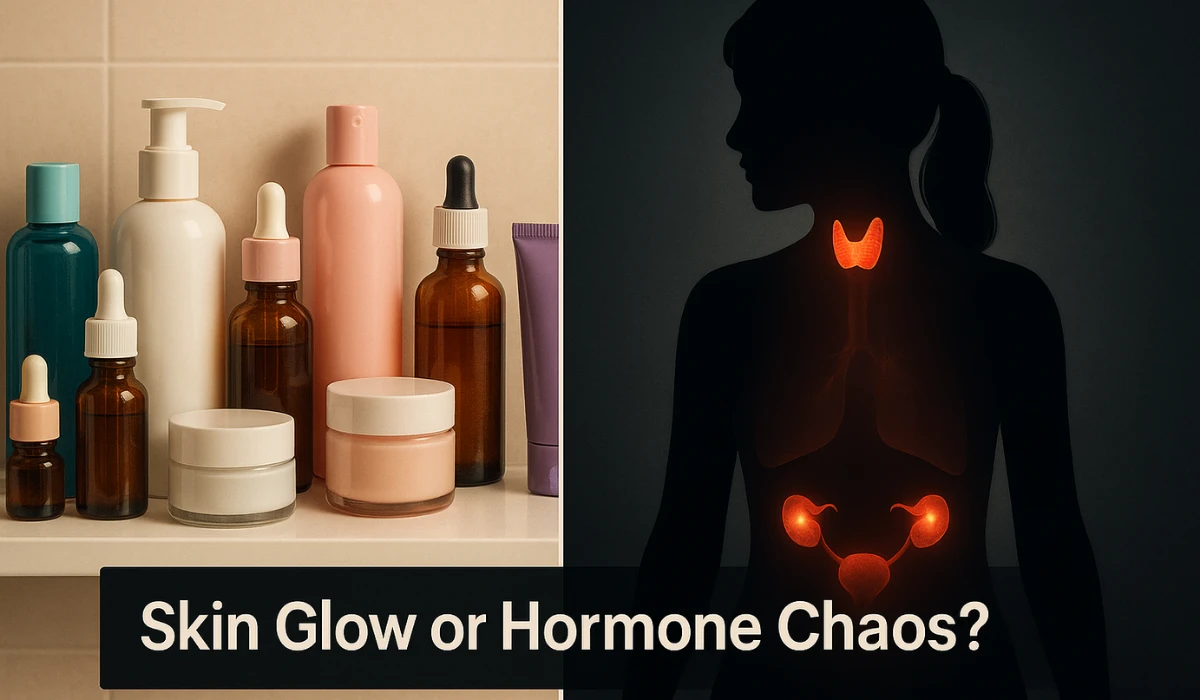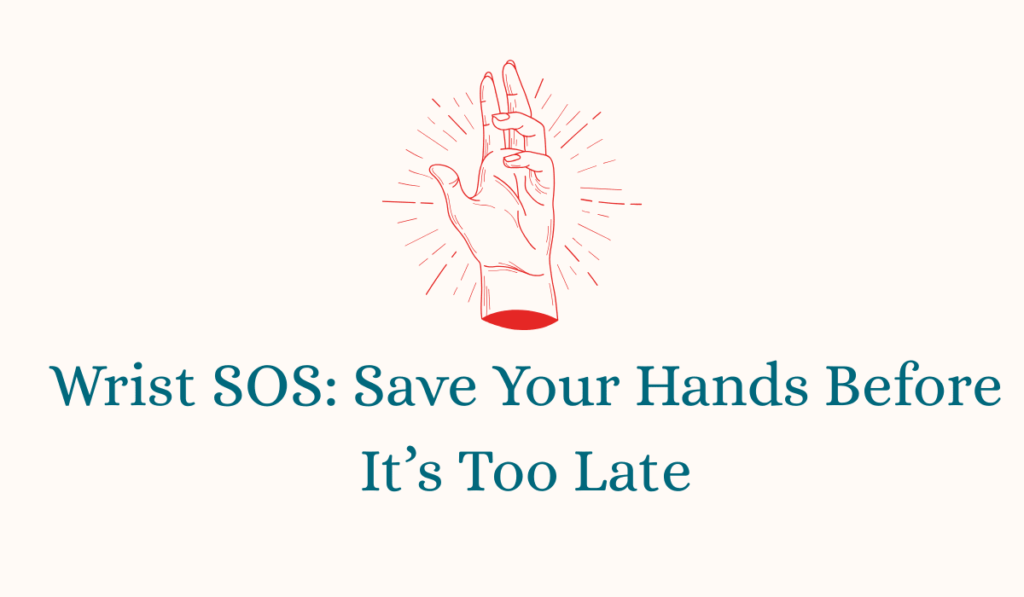Skin Glow or Hormone Chaos: Are Your Beauty Habits Messing With Your Hormones?
In today’s world, the beauty industry thrives on our deepest insecurity: the need to look flawless. Every scroll on social media convinces us that a longer skincare routine equals better skin.
Double cleanser. Toner. Essence. Serum. Retinol. Brightening activities. Sunscreen. Another layer at night.
Step by step, products are sold as “essential” — and before we know it, our shelves are overflowing and our skin is being overwhelmed by chemicals.
But here’s the real question: do we really need them all? Or are we unknowingly trading healthy skin and balanced hormones for the illusion of perfection?
The Invisible Trade-Off: Hormones vs. Cosmetics
Most skincare and cosmetic products contain endocrine-disrupting chemicals (EDCs). These substances can mimic or block your natural hormones — especially estrogen, progesterone, and thyroid hormones. Over time, this interference can quietly shift your body’s internal balance.
Here are some common culprits:
- Parabens – preservatives in creams, shampoos, and makeup. Linked to fertility issues and early puberty in girls.
- Phthalates – found in fragrances, lotions, nail polish. Associated with altered thyroid function and insulin resistance.
- Oxybenzone & Benzophenones – common in sunscreens. Known to disrupt estrogen pathways and increase breast cancer risk.
- Triclosan – an antibacterial agent in soaps and toothpaste. Interferes with thyroid hormone metabolism.
The irony? Many of these products are marketed as “skin-friendly” or “dermatologist-approved.”
How Topical Products Affect Internal Systems
You may wonder: “But if I’m just applying it on my skin, how does it reach my hormones?”
Here’s the science:
- Skin Absorption – Your skin isn’t a solid wall. It’s semi-permeable. Many small chemical molecules (like parabens and phthalates) penetrate the skin barrier and enter your bloodstream.
- Cumulative Exposure – Daily layering multiplies the exposure. What you apply doesn’t vanish — your body metabolizes and processes it. The constant load strains your liver, thyroid, and reproductive system.
- Skin-Hormone Communication – Skin itself is an endocrine organ. It produces hormones (like cortisol, melatonin, and sex hormones in small amounts) and communicates with your immune and reproductive systems. Disrupting the skin barrier sends “stress signals” to your entire body.
- Microbiome Disruption – Harsh cleansers and preservatives alter the skin’s microbial community. Just like gut bacteria, skin microbes regulate immunity, inflammation, and even hormonal signaling. A disrupted microbiome worsens acne, eczema, and PMS-related skin flares.
This is why “topical” doesn’t stay topical — it becomes systemic.
When Skincare Turns Into a Stressor
Clients often share stories like:
- “I suddenly started experiencing more acne after switching to an expensive routine.”
- “My PMS symptoms worsened after I began using multiple serums.”
- “Despite eating healthy, my skin feels inflamed and my cycles irregular.”
What they didn’t realize: skin and hormones are deeply connected. By overloading the skin with actives, fragrances, and preservatives, we don’t just irritate the surface — we trigger systemic stress responses.
The Over-Sanitization Trap
Then there’s the obsession with cleansing everything. Double cleansing, daily exfoliation, and oil-stripping face washes.
This erodes the skin microbiome — the protective layer of good bacteria. Without it, your skin becomes more vulnerable to infections, inflammation, and even hormonal flare-ups.
Just like the gut, your skin needs microbial diversity, not chemical sterilization.
The Better Way: Practical Steps for Hormone-Friendly Skin
Healthy, glowing skin doesn’t require 12 bottles. It requires balance — for your skin and your hormones. Here’s how to simplify without compromising protection:
1. Simplify Cleansing
- Wash your face once a day with lukewarm water.
- Use mild natural cleansers like besan (chickpea flour) or oats paste 2–3 times a week.
- Avoid foaming cleansers with sulfates or alcohol.
2. Moisturize Naturally
- Apply cold-pressed oils (coconut, almond, sesame) in small amounts at night.
- For dry skin, use homemade ghee as a thin layer — it nourishes without disrupting hormones.
3. Choose Safe Sun Protection
- Skip chemical sunscreens with oxybenzone.
- Opt for mineral-based sunscreens containing zinc oxide or titanium dioxide, especially if you’re outdoors for long hours.
- Indoors? Limit sunscreen use — let your skin breathe.
4. Support Skin from Within
Healthy skin is built in your kitchen, not just your bathroom shelf.
Hydration
- Drink 2–3 liters of water daily in small sips.
- Add mint, lemon, or cucumber for antioxidant-rich infused water.
- Limit excess caffeine and alcohol, which dehydrates skin.
Foods That Nourish Skin and Balance Hormones
- Vitamin C sources: Oranges, lemons, amla → boost collagen and repair oxidative stress.
- Antioxidant-rich foods: Berries (blueberries, strawberries) → fight skin inflammation.
- Hydrating foods: Cucumbers, melons → restore skin moisture.
- Beta-carotene sources: Carrots, pumpkin, sweet potatoes → convert into Vitamin A for skin repair.
- Seeds & nuts: Flax, chia, pumpkin, sunflower, almonds, walnuts → regulate estrogen, reduce PMS flares, and add omega-3s.
- Fermented foods: Curd, idli, dosa, sauerkraut → support gut health, which reflects in skin clarity.
Protein & Healthy Fats
- Protein from lentils, beans, quinoa → builds collagen, keratin, and elastin.
- Healthy fats from avocado, coconut, ghee, olive oil → reduce skin inflammation.
Daily Rituals
- Start mornings with warm water + lemon (aids liver detox).
- Mid-morning snack: 1 seasonal fruit + handful of nuts/seeds.
- Evenings: Herbal teas (chamomile, tulsi) to lower cortisol and prevent stress breakouts.
- Sleep 7–8 hours for deep repair.
5. Protect Your Skin Microbiome
- Avoid daily scrubs or harsh antibacterial soaps.
- Let your natural skin oils and microbes do their protective job.
6. Lifestyle Tweaks
- Get 10–15 minutes of morning sunlight to regulate Vitamin D and circadian rhythm.
- Sleep deeply — growth hormones released at night are your skin’s best repair crew.
- Practice stress relief techniques (such as yoga, meditation, and breathwork) — stress hormones like cortisol can directly worsen acne and dullness.
Safety Checklist
If you still want to buy skincare products, shop smart. Beyond checking ingredients, also look at what’s printed on the label:
Avoid
- Parabens, Phthalates (often hidden under “fragrance”), Oxybenzone, Triclosan, Sulfates, Formaldehyde-releasing preservatives, Synthetic fragrances.
Safer Choices
- Ingredients: Zinc oxide, Titanium dioxide, Aloe vera, Shea butter, Coconut oil, Almond oil, Ghee, Sodium benzoate, Potassium sorbate.
- Labels must show: Full ingredient list, expiry date, manufacturer/importer details.
- Certifications / Approvals:
- Manufacturing license number → ensures product is made in a licensed facility under India’s Cosmetics Rules 2020.
- Import registration number (Form COS-2) → confirms imported products are legally registered with CDSCO.
- ISI mark (BIS) → shows conformity with Indian safety standards (mandatory for some categories like hair dyes, skin powders).
Consumer Tip: If a product skips these details, think twice. Missing license, registration, or ISI mark is a red flag.
Bottom Line
The beauty industry thrives on fear: fear of aging, fear of imperfections, fear of not being “enough.” But your body does not need a 12-step chemical cocktail to glow. It needs balance.
Your skin is not just a cosmetic layer — it’s an endocrine organ in conversation with your entire system. What you put on it doesn’t stay on it.
So before layering another serum, pause and ask:
Is this healing my skin or quietly hijacking my hormones?
At IntuiWell, we help you cut through health gimmicks and return to roots: simple, practical, hormone-friendly ways to care for your body inside and out.
💡 “Your hormones and your skin deserve balance — not confusion. If you’re tired of endless products and want a personalized, hormone-friendly skincare roadmap,
book a free discovery call with IntuiWell today.
👉 [Book Your Call Now]
📝 Summary
Skin Glow or Hormone Chaos: Are Your Beauty Habits Messing With Your Hormones?
The beauty industry has sold us the myth that more products equal better skin. But many cosmetics contain endocrine-disrupting chemicals (EDCs) like parabens, phthalates, and oxybenzone that quietly interfere with hormones, fertility, thyroid, and immunity.
Your skin isn’t just a surface — it’s an active endocrine organ. What you put on it gets absorbed, alters your microbiome, and impacts systemic health. Over-sanitization and 12-step routines often do more harm than good.
Instead, healthy skin comes from balance: simple cleansing, natural moisturizers, mineral-based sun protection, nourishing foods, hydration, stress management, and proper sleep. By simplifying routines and choosing safer ingredients, you can glow without hormone chaos.
❓ FAQs
Q1. How do I know if my skincare is affecting my hormones?
Watch for signs like irregular cycles, worsened PMS, unexplained acne, or thyroid issues that started after switching to new skincare.
Q2. Are all cosmetics harmful?
No. The key is to avoid EDCs like parabens, phthalates, oxybenzone, and triclosan. Choose products with safe, minimal ingredients.
Q3. Do I really need sunscreen every day?
Outdoors — yes (choose mineral-based). Indoors — not always. Letting your skin breathe is equally important.
Q4. Can food really improve skin health?
Yes! Nutrients from Vitamin C, antioxidants, omega-3s, and fermented foods support collagen, reduce inflammation, and balance hormones better than most serums.
Q5. What’s the first step to safer skincare?
Simplify. Cut unnecessary layers, check ingredient labels, and protect your skin microbiome with gentle, natural care.



